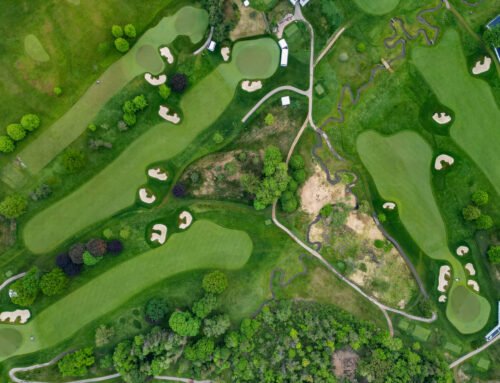November 10, 2022 and I’m standing in the middle of the 10th fairway at Tarandowah. We didn’t know it at the time, but the 17 degree Celsius high for the day would be heavily juxtapositioned by snow a mere four days later, so this was it for the year.
Martin Hawtree’s lone Canadian design is not exactly a part of the Greater Toronto Area, but it is not difficult to get to, either. From the airport, you would take the 427 south to Highway 401 west, and then from there, a single exit takes you to Avon, Ontario. From my house, it clocks in at 90 minutes door to door, but I have to pick up Nicole Jordan, one of Cabot’s talented marketing gurus, so it takes a little longer. Our playing partners for the day are Robert Thompson and Rick Young, two of Canada’s all-time great golf journalists who love to play early, meaning our 90 minute drive from High Park, Toronto is mostly in the dark. On the drive, I tell Nicole, “it doesn’t take much for me to drive 90 minutes to a golf course, but to go for a second time, it takes a lot.” This is more of a reflection of the 400+ golf courses I’ve played, but having been to Tarandowah at least twice a year following my first visit in 2020, it also acts as an endorsement to what I think of the place.

Our round begins on the back nine, and after negotiating with the centreline tree (yes, a centreline tree, though not as contrived as it sounds) off the tee, the approach to the par 4, 10th is always a difficult task, but even more so as the opening approach for the day. The practice putting green gave fair warning: it is firm (hitting little pitch shots, the ball bounces to my knee), so I knew what to expect. Only 109 yards, but further complicated by the conditions, the questions arise: where do I land this? Do I chip it about 75 yards and see what happens? Bump a 9 iron? Putt it? Putting comes later, so I elect to hit a full 60 degree and see what happens; a litmus test of sorts for the rest of the day. It lands into the pushed up front edge, killing it in its tracks. Had it been 5 yards shorter, it might land on flat ground and bounce up; 5 yards longer, and it could bounce to the back of the green. Oh, the joys of links golf.
By definition, Tarandowah is not an authentic links though, but what is these days? No longer do we have to worry about not being able to farm or develop the sandy soils between the farmland inland, and the ocean. Even Cabot Links, Canada’s closest thing to the real deal, is arguable (the main component is sand, and while Links is sandcapped, it is debatable if that counts the same as natural sand found on site). No ocean or sand at Tarandowah, and instead of preserving the farmland to, well, farm, we play directly on top of it (note: in the infant years of links golf, technology was minimal and as a result, they needed to save every inch of farmable land for food). We still get the rollicking terrain, detailed surrounds, and the landscape is still windy and exposed, but we are hundreds of miles from an ocean. Regardless, Tarandowah is about as close as we get in Canada, and certainly for Ontario.
The difficulties of links golf are certainly present at Tarandowah, as evident by the approach on the 10th. What other style of golf has the golfer thinking about putting from outside 100 yards? Thankfully, this is not an isolated incident the golfer has to overcome on just the 10th. In fact, every single approach shot asks the golfer to strategically navigate Martin Hawtree’s wavy fairway surrounds, often with bunkers set back from the front edge of the green. Without the excellent work from superintendent Dan Lavis, these bunkers become obsolete. With how firm Tarandowah plays, Martin Hawtree’s vision for his golf course remains properly presented. For good players, you can sometimes hit it high and spin it, but when the turf is this firm and this bouncy, that becomes difficult. When the conditions present themselves to favour the ground game, why not use it?

Given how Tarandowah plays on a daily basis, the vision behind the golf course becomes clear. “This is the hardest golf course to get the ball close to the flag in Ontario” I tell Robert Thompson, who agrees. He is the resident Tarandowah expert, and typically, my playing partner when I come down. Mind you, my quip comes after I pull putter from a wedge distance for the second time on three holes. Once on the par 4, 2nd from about 55 yards, and another on the par 4, 4th from a little longer. One is successful, one is not; the trickery is it worked the first time, so I thought the second time would work as well.

Putting is just one of the unique ways to play into these greens, and certainly the most unconventional. On the par 3, 15th, I attempt what had to be a 60 yard slice to ride the wind and get close to the flag. On the 12th, a hooded 8 iron hooking to get to a left flag. We get the privilege of trying to carry the burn directly into the wind on the 17th, so coming into the green, I hoist it high. On the par 3, 7th, I chip a 4 iron under the wind. All in a days work in Tarandowah. Nowhere else between Sagebrush and Cabot Links do I feel like I’ve gone to battle like here, and nowhere else is the feeling as gratifying if you come out on top. The variety in shots required is something not even Stanley Thompson can provide in 2022, and that comes from a Stanley Thompson mega fan.

Aside from the metaphysical elements of Martin Hawtree’s masterpiece, the actual architecture merits are awe-inspiring. The routing playfully intertwines with itself. A gathering point behind the 5th/16th green provides a meeting place to watch the tee shots at the 6th—a standpoint par 4 in my view—and the 17th, one of the most difficult holes. In a windy location like southwestern Ontario, the variety is key. Only two of the par 3’s play in the same direction: the 3rd and 15th both head east, but the former is a middle length par 3 favouring a draw (and actually features elements of a Redan), while the latter is a long par 3 preferring a fade.
It doesn’t take much for me to drive 90 minutes to a golf course, but to go for a second time, it takes a lot
Even when the golf course interacts with the creek, it is with variety. On the par 4, 4th, a Victorian-era style hazard presents itself in the landing zone of the tee shot. Prior to the birth of strategy in golf architecture at Woking in England, many golf courses had hazards that every golfer had to cross with the sole purpose of being penal or difficult. This era (and style of architecture) is still referred to as Victorian, but as the birth of angles and strategy came, no longer did every golfer have to cross the hazards at the same distance. Instead, various crossing points tempted golfers into their preferred line. Generally speaking, the longer the carry on the first shot, the better angle coming in; the shorter carry (or easier tee shot), the more difficult the second shot becomes. On the 17th, the second time we cross the burn on a par 4, the dogleg left par 4 crosses the burn at an angle, asking golfers to play to the inside corner for an easier carry. Even on the par 3’s that bisect the burn, they come into different contact points. You hardly notice it on the par 3, 7th, while it looms on the 12th, awaiting a mishit short of the green.
What is the secret sauce of a place like Tarandowah? Well, it is not that simple. At a golf course as good as this southwestern Ontario gem, it is the sum of parts. Like a bridge, many trusses must hold merit to be able to keep up the roadway for cars to pass over. Tarandowah’s trusses are Martin Hawtree’s beautiful attention to detail, further complimented by the grounds department’s dedication to having the golf course present as it should. Furthermore, the macro details, like the rise and fall throughout the golf course is good, but the micro, and specifically in and around the greens, are among the single most interesting in the country. The secret sauce of Tarandowah is something only uncovered in the dirt on-site, and subsequent visits only further reveal the secrets of a golf course as good as this. Who would have thought Ontario’s best public golf course would still be a “hidden gem?”








Leave A Comment